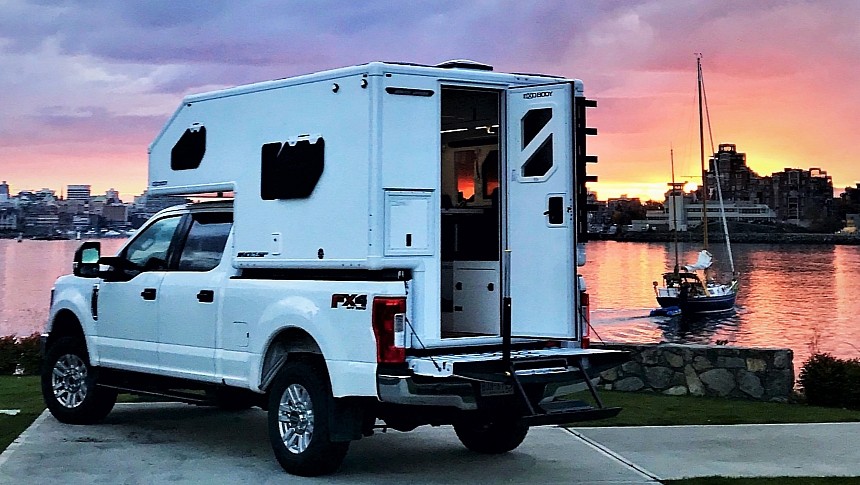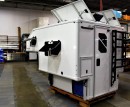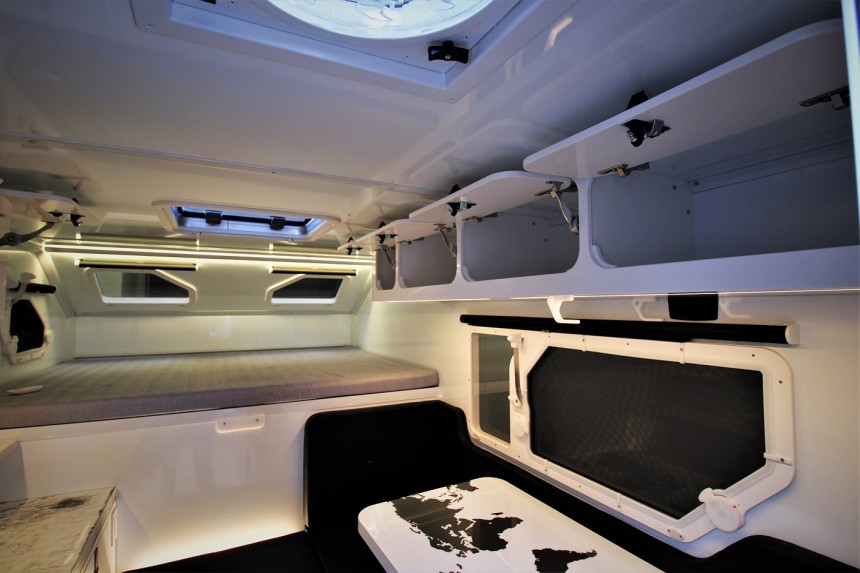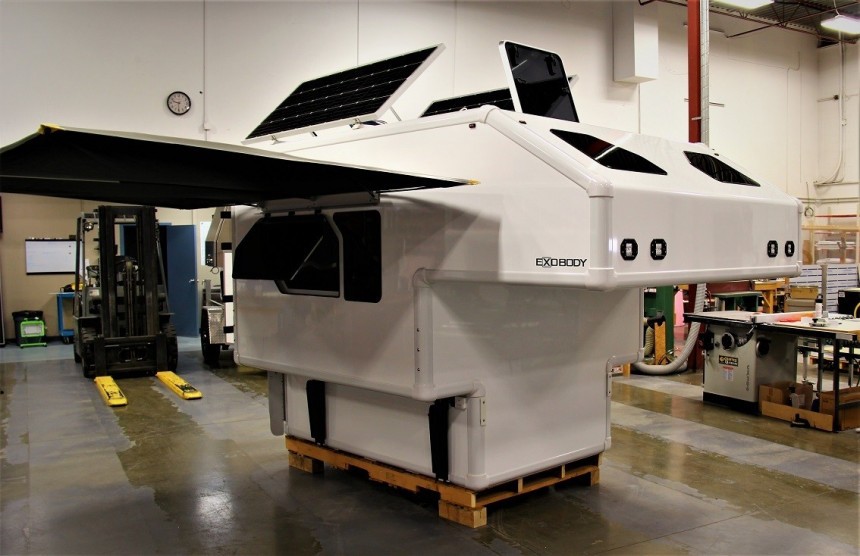There I was, minding my own business, searching for the hardest-hitting truck campers around, when I met a Canadian crew dubbed Armorlite Technologies Inc. They're the ones responsible for the EXP-1 overland machine you have before you today.
Folks, Armorlite may not sound familiar to you, but that doesn't matter. What matters most is that this crew has been building mobile habitats and vehicles for the industrial sector for years now, unfurling their activity out of Canada. However, they finally decided to put all their design and manufacturing know-how into a lineup of consumer-ready overland truck campers, of which the EXP-1 is one of them.
Now, Armorlite has made a name for itself by specializing in vehicle-mounted habitats to be used in an array of industries, including law enforcement, healthcare (ambulatory services), and several others. So, whenever a crew tapers to the needs of some of the most solicited vehicles around, you can bet your bottom dollar that you're in for a different kind of camper, to say the least.
Well, as I dove into the EXP-1 and all it has to offer us, I ran across a term dubbed Exo-Body. This is a trademarked design and building process that results in a camper that's not only strong enough to handle what overland adventures throw at you but it's also light and insulated to make it through the harshest terrains. After all, Canada isn't the most gentle of landscapes.
In short, EXP-1 units, much like all the other products to come out of Armorlite, panels are completed using "structural-grade" aluminum with a high-density core of insulation. The frame itself is crafted from aluminum extrusion profiles tuned to absorb high racking and twisting forces often encountered when you're romping about on uneven terrain. Oh, and wood or any other organic materials have no place in an Armorlite EXP-1.
The result of this magic is a camper that weighs 1,519 lbs (689 kg) dry and is 83.5 in (212 cm) tall, 79.8 in (202 cm) wide, and 140 in (355 cm) long. But it's what's in this space that shocked me the most. As Armorlite likes to say, "The EXP-1 was designed to provide most of the comforts of home while still being fully capable off-road."
What does "most of the comforts of home mean?" Well, that's what we're here to find out, and surprisingly, "most of" only accounts for one feature missing: a shower room or wet bath. Inside each unit, future owners are able to access an induction cooktop, sink with water pump, a fridge, and sleeping space for up to three guests, made possible by an elevated queen bed and a 32x75 in (81x190 cm) dinette bed.
One aspect of the interior I want to shed some light on is the storage space. From cabinets at your feet to overhead bays, there's a place to bring along clothing, books, devices, foodstuffs, and anything else you may need. Be sure to view the image in the gallery if you haven't done so already.
As for the all-important off-grid systems that overland explorers need, this is yet again where Armorlite's know-how shines. First of all, whenever you start adding solar panels, inverters, and battery banks to a camper, you start to mess around with some very crucial dynamics.
For example, by loading traditional panels onto your RV's roof, you'll add countless pounds of weight to your unit. Once you take that idea and apply it to a truck camper that's exposed to all sorts of approach and departure angles, not to mention twisting or torsion forces, you really need to think things through so you don't create an unbalanced vehicle.
Well, Armorlite took the time to explore the best options for the EXP-1 and, in doing so, has opted for thin-film solar panels to help balance the EXP-1. As standard 400 W are in place, and so is a 2,000 W inverter, 240 Ah battery bank with cold-weather protection, and a BMS.
Not only does this setup allow us to take our adventures away from the campgrounds, but it's also used to power all those comforts of home. This means that the electric hot water tank will be tapping into sun-fed juice, and so will lighting, the cooktop, fridge, and all the other knick-knacks you'll be using. Heating, however, is provided by an Espar D2 diesel heater.
If we put all that together and into one neat mobile habitat, the EXP-1 would be the result, but what does it mean for our lifestyles? Well, we need to consider that all that I've mentioned, and then some, is going to cost, according to Armorlite's website, at least $84,700 Canadian, which is roughly $62,200 (at current exchange rates).
But there's a catch: this seems to be the price they set back in 2020, so expect things to be a bit different after three years and all sorts of global logistics turmoil we've seen in recent years; clearly, these babies haven't gotten any cheaper. However, remember what you're buying: a truck camper that's been tuned over the years and born of experience granted from working with countless other industries. Just a little something-something to think about.
Now, Armorlite has made a name for itself by specializing in vehicle-mounted habitats to be used in an array of industries, including law enforcement, healthcare (ambulatory services), and several others. So, whenever a crew tapers to the needs of some of the most solicited vehicles around, you can bet your bottom dollar that you're in for a different kind of camper, to say the least.
Well, as I dove into the EXP-1 and all it has to offer us, I ran across a term dubbed Exo-Body. This is a trademarked design and building process that results in a camper that's not only strong enough to handle what overland adventures throw at you but it's also light and insulated to make it through the harshest terrains. After all, Canada isn't the most gentle of landscapes.
In short, EXP-1 units, much like all the other products to come out of Armorlite, panels are completed using "structural-grade" aluminum with a high-density core of insulation. The frame itself is crafted from aluminum extrusion profiles tuned to absorb high racking and twisting forces often encountered when you're romping about on uneven terrain. Oh, and wood or any other organic materials have no place in an Armorlite EXP-1.
What does "most of the comforts of home mean?" Well, that's what we're here to find out, and surprisingly, "most of" only accounts for one feature missing: a shower room or wet bath. Inside each unit, future owners are able to access an induction cooktop, sink with water pump, a fridge, and sleeping space for up to three guests, made possible by an elevated queen bed and a 32x75 in (81x190 cm) dinette bed.
One aspect of the interior I want to shed some light on is the storage space. From cabinets at your feet to overhead bays, there's a place to bring along clothing, books, devices, foodstuffs, and anything else you may need. Be sure to view the image in the gallery if you haven't done so already.
As for the all-important off-grid systems that overland explorers need, this is yet again where Armorlite's know-how shines. First of all, whenever you start adding solar panels, inverters, and battery banks to a camper, you start to mess around with some very crucial dynamics.
For example, by loading traditional panels onto your RV's roof, you'll add countless pounds of weight to your unit. Once you take that idea and apply it to a truck camper that's exposed to all sorts of approach and departure angles, not to mention twisting or torsion forces, you really need to think things through so you don't create an unbalanced vehicle.
Not only does this setup allow us to take our adventures away from the campgrounds, but it's also used to power all those comforts of home. This means that the electric hot water tank will be tapping into sun-fed juice, and so will lighting, the cooktop, fridge, and all the other knick-knacks you'll be using. Heating, however, is provided by an Espar D2 diesel heater.
If we put all that together and into one neat mobile habitat, the EXP-1 would be the result, but what does it mean for our lifestyles? Well, we need to consider that all that I've mentioned, and then some, is going to cost, according to Armorlite's website, at least $84,700 Canadian, which is roughly $62,200 (at current exchange rates).
But there's a catch: this seems to be the price they set back in 2020, so expect things to be a bit different after three years and all sorts of global logistics turmoil we've seen in recent years; clearly, these babies haven't gotten any cheaper. However, remember what you're buying: a truck camper that's been tuned over the years and born of experience granted from working with countless other industries. Just a little something-something to think about.













